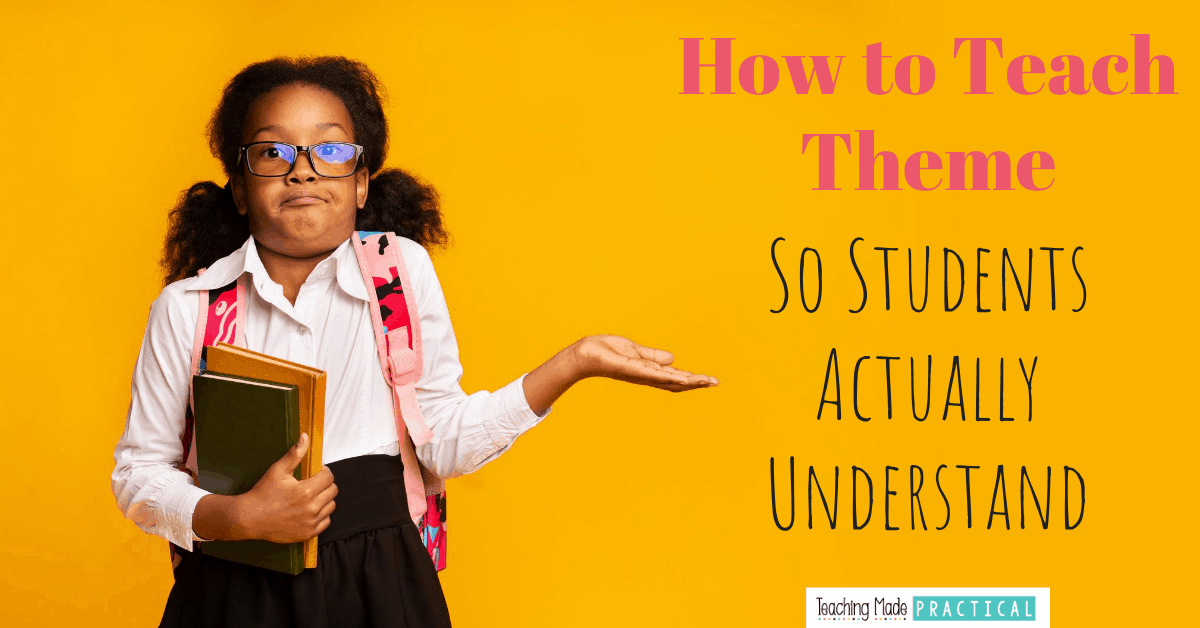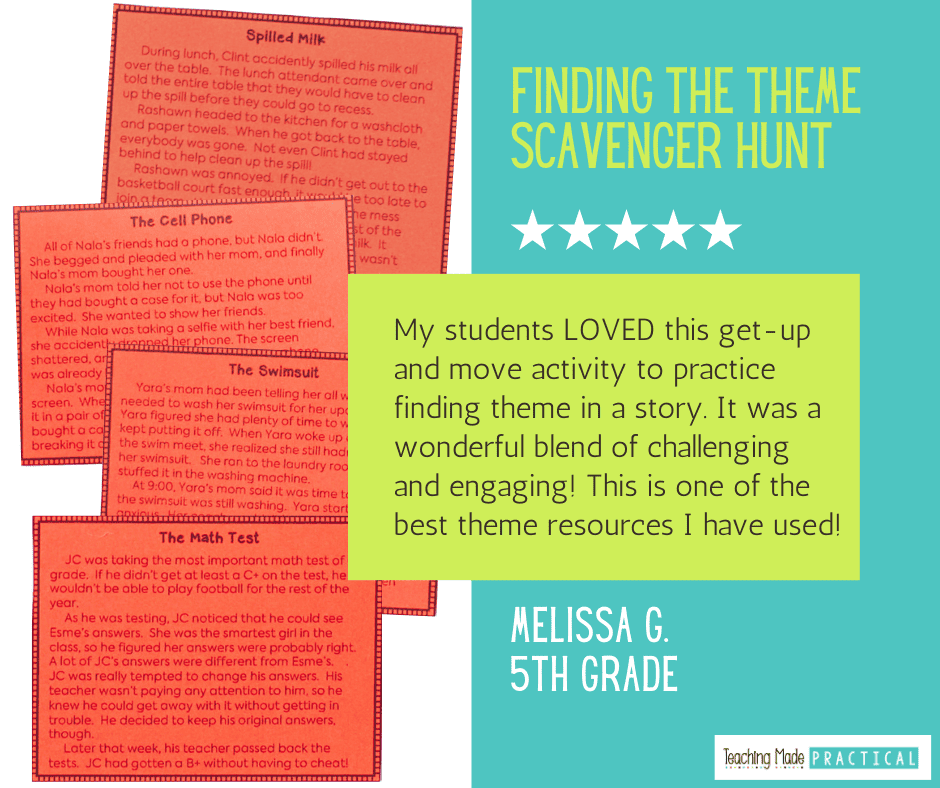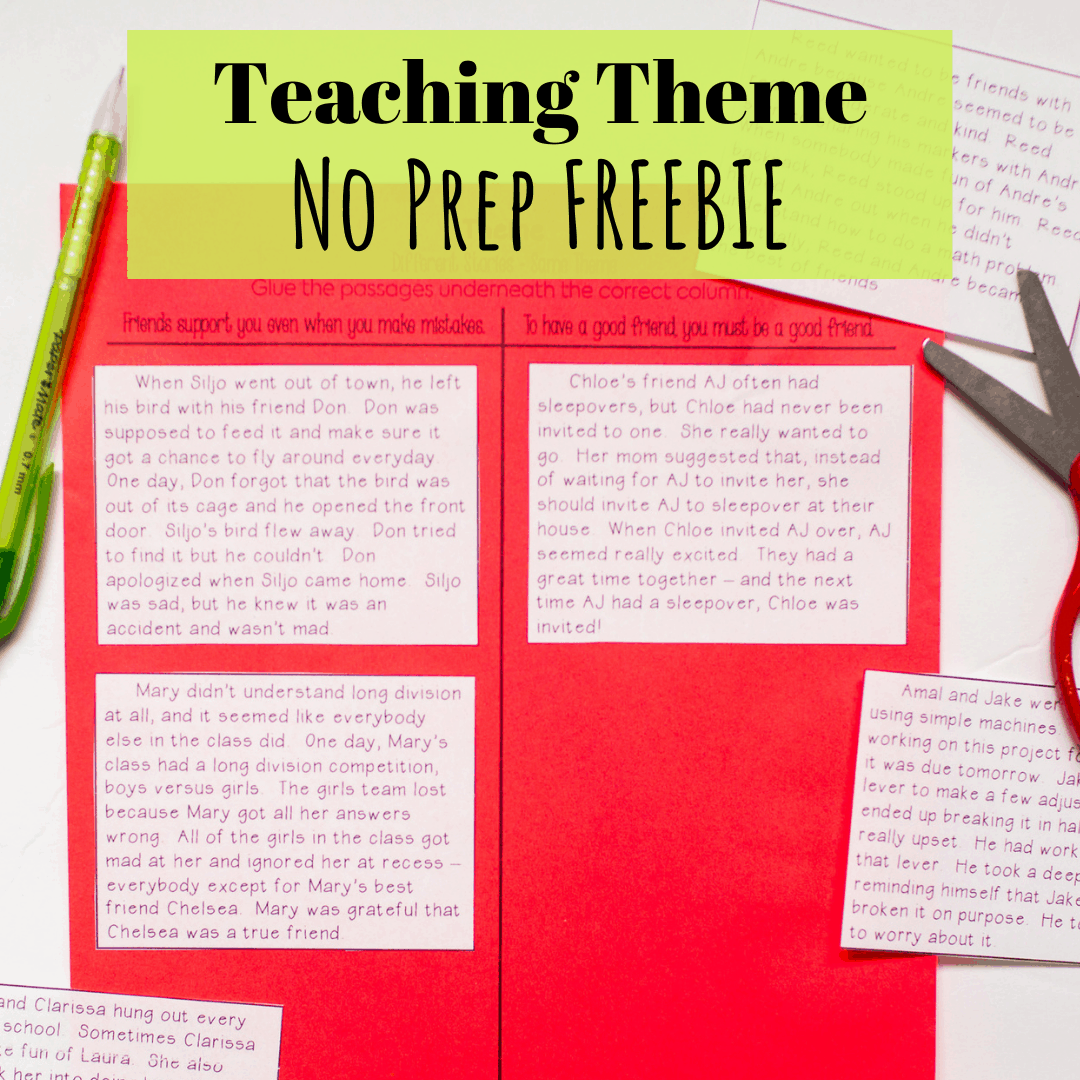
Teaching theme to 3rd grade, 4th grade, or 5th grade students is just plain HARD. Theme is an abstract idea, making it really hard for teachers to put into words and even harder for students to grasp.
If your students are struggling with understanding theme, rest assured that they are not alone! Teachers all over the world have this same struggle.
Teachers often teach theme by creating anchor charts that list common themes or that list questions students should ask themselves when trying to determine the theme of a passage or story. These are helpful and good strategies to use, but most students will still have no clue how to determine the theme independently just through the anchor charts.
There are other strategies you can use to help scaffold student understanding.
Why Teaching Theme is So Hard
Students struggle with theme because it is unlike anything else they have learned in their ELA classroom.
In order to identify the theme of a text, students must also have the ability to summarize important parts of a text so that they have a clear understanding of what an entire passage says. Students must be able to distinguish the theme from the main idea. They must understand what lesson the author is trying to teach and recognize that they can disagree with the author's point of view. They must have a solid grasp of story elements and how characters change. They must be able to make inferences.
On top of all of that, students must understand how to actually determine the theme, which is a challenge in itself. No wonder teaching theme is so hard!
Make Sure Students Have a Solid Foundation
If your 3rd, 4th, 5th, or 6th grade students struggle with summarizing or determining the main idea, then figuring out how to determine the theme of a story will be almost impossible.
If you have students that are still struggling with these skills, then check out these tips for teaching students to summarize so that they actually understand, and how to determine the main idea so that they actually understand.
Introduce Theme With Shorter Text
Shorter texts allow for plenty of opportunities for you to model how to find the theme of a story and plenty of opportunities for students to practice.
Shorter texts keep students from being overwhelmed and getting frustrated.
Shorter texts allow you to focus primarily on finding the theme, and less on decoding words and difficult vocabulary.
Shorter texts make it easier for you to determine where your students are struggling and how to reteach.
Shorter texts for practicing theme can be hard to find. Use this no prep theme freebie with short texts to help make your theme lesson planning easier.
Shorter texts are simply a must-have when introducing your students to theme.
Teach Confusing Aspects of Theme in Isolation
Often theme instruction is limited to explaining what theme is, providing examples of theme, and modeling to students how to find the theme of a story.
But there are many aspects to theme that can be confusing for students. By teaching each of these in isolation, you can more easily figure out where your students are struggling.
The aspects of theme that I have found confuse students the most - as well as ideas for teaching each aspect - are below.
- Themes aren't usually stated in the passage. To help students better understand this, have students read a paragraph with a clear theme. Tell students the theme of this paragraph, using a think aloud to explain how you figured it out. Go back and reread the passage, showing students that the theme was not stated anywhere in the passage.
- Completely different stories can have the same theme. Seeing the same theme played out with a variety of different characters and plots can really help students better understand how to determine the theme. Read several very different paragraphs, each with the same theme to students. This resource contains 16 different short stories, each with one of 4 themes, to make teaching this aspect of theme easy on you.
- Theme and main idea are different. This is essential for students to understand, but very hard to teach. To help students understand this, have them read a short passage with a clear theme. Then, write 5 statements - 3 details from the passage, the main idea of the passage, and the theme of the passage. Do not tell students what is what, but instead have them figure that out. Doing this activity repeatedly really helps solidify students' understanding of the difference between main idea and theme. If your students are still struggling with main idea, then this activity will also help them be better able to differentiate between main idea and details. (This is one of the most popular activities in my Teaching Theme Bundle.)

- You don't have to agree with the theme. This is particularly important in a world where biased information is available everywhere. Students need to know that they do not have to agree with everything they read. A good way to do this is to show students two paragraphs with opposing themes and have students discuss which theme they agree with more. For example, you could have a paragraph with the theme of "You can always trust your friends" and another paragraph with the theme of "If you want something done right, you have to do it yourself."
- A reading passage or text can have more than one theme. This can be confusing to students, as not all passages have more than one theme, while novels almost always do. Build up to determining the theme of novels by showing students shorter passages with at least two themes.
- Themes are meant to apply to real life. This is an important aspect of theme - themes are not just a lesson for the characters in a story. The author intends for people to learn from the theme of a story. To practice this, read short passages with clear themes and, after identifying the theme, ask students how they could apply it to their own lives. (Or have them explain why they wouldn't want to apply it to their own life.)
Low Prep Resources to Help Your Students Understand Theme
Most theme resources simply provide students with more practice. They don't help students better understand theme.
If you find teaching theme to be frustrated, or if you have students that just don't get it, then this no prep resource will make your life easier and leave your students with a much clearer understanding of how to find the theme of a story.
It includes activities to help students practice each of the confusing concepts listed above in isolation, and it includes plenty of shorter texts to keep students from feeling overwhelmed.
"I can't tell you how much I love this! Theme is so tough for fourth graders but this unit explained the nuances so well. I'll be using this every year!"
"I have the main idea scaffolded resource and love it, so I knew this was a good choice for theme. Because theme is such a difficult concept for most students, I wanted something that really broke it down into manageable chunks, and this did that."
Download this cut and paste theme freebie here!



